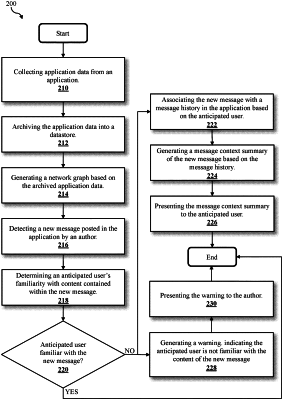| CPC G06F 16/345 (2019.01) [G06F 9/542 (2013.01); H04L 51/216 (2022.05); H04L 51/52 (2022.05)] | 20 Claims |

|
1. A method for message context summary generation, the method comprising:
collecting, by a computing device, application data from an application;
archiving, by the computing device, the application data into a datastore;
generating, by the computing device, a network graph based on the archived application data;
detecting, by the computing device, a new message posted in the application by an author; the new message containing content on one or more topics;
determining, by the computing device, familiarity of the content of the new message by an anticipated user, wherein familiarity is based on the anticipated user's interaction history with the author over a plurality of channels within the application, and wherein the anticipated user's interaction history includes a time of last viewing one or more relevant messages of the author over the plurality of channels, commenting on the one or more relevant messages of the author over the plurality of channels, and participation metrics between the anticipated user and the one or more relevant messages of the author over the plurality of channels;
associating, by the computing device, the new message with a conjoined message history in the application to establish a context, based on the anticipated user, wherein the conjoined message history may comprise one or more logically ordered messages between various users over the plurality of channels within the application;
generating, by the computing device, a message content summary and context of the new message based on the conjoined message history; and
presenting, by the computing device, the message content summary and context in a sequence of contextual messages, to the anticipated user, wherein the sequence of contextual messages allows the author and the anticipated user to avoid misunderstandings and more fully engage in a discussion within the channel.
|